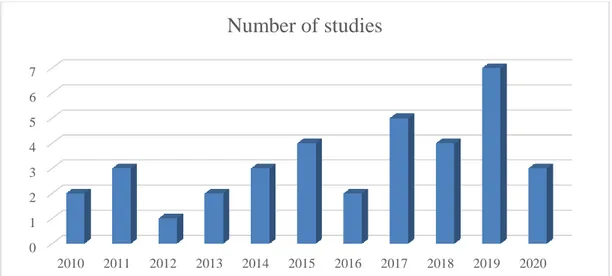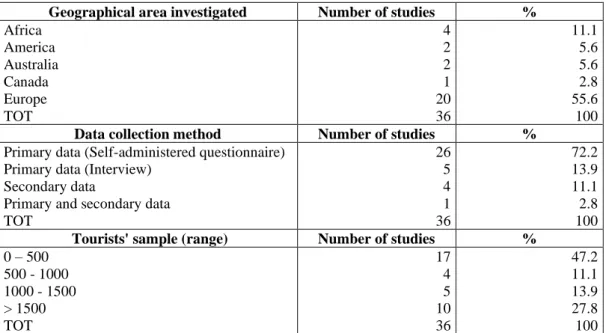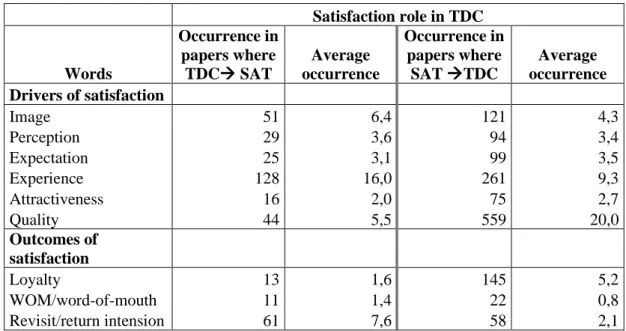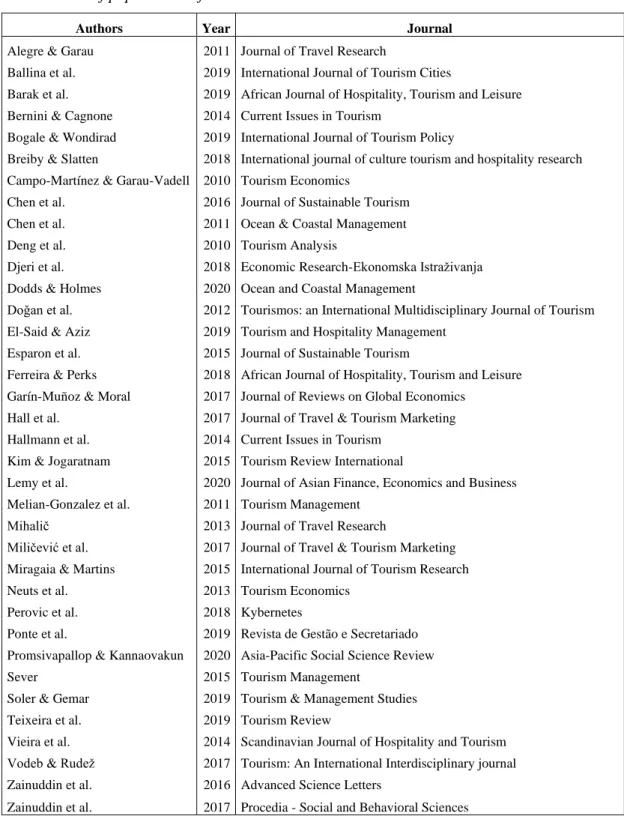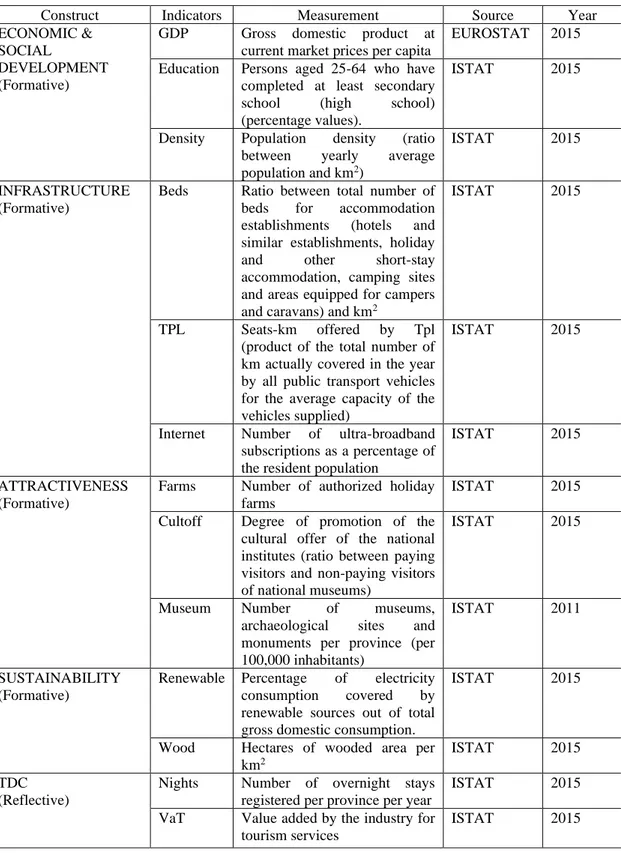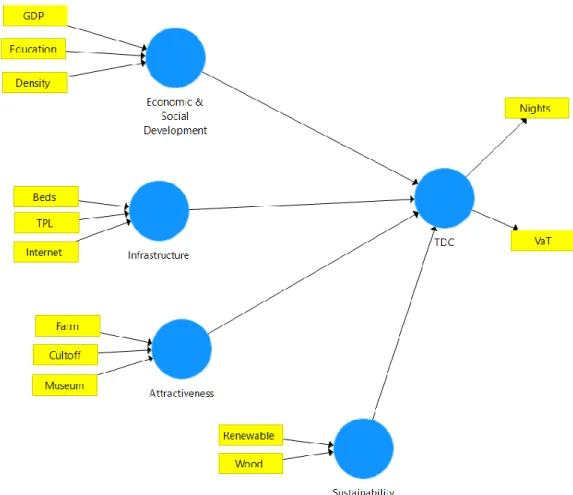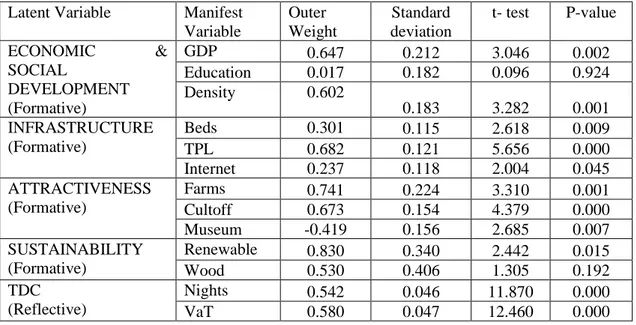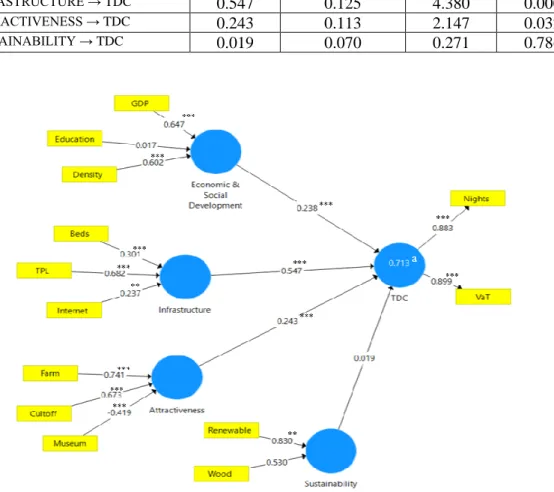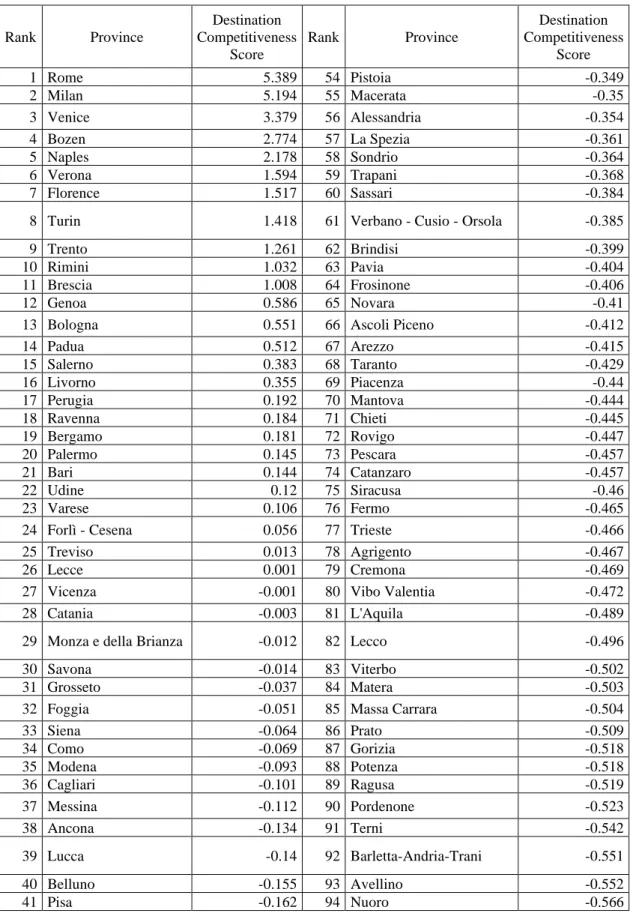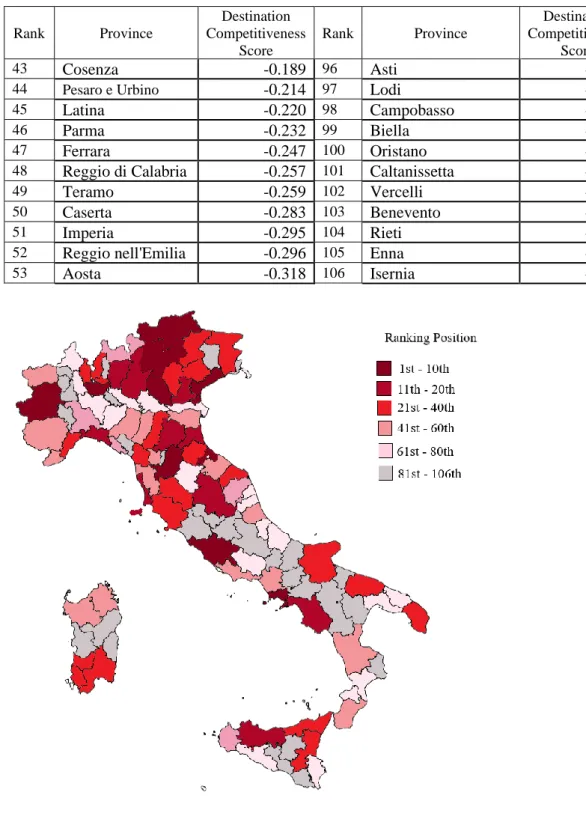UNIVERSITY OF MESSINA
DEPARTMENT OF ECONOMICS
RESEARCH DOCTORATE COURSE IN ECONOMICS, MANAGEMENT AND STATISTICS
XXXIII CYCLE
All roads lead to Rome… and not
only. Assessment of competitiveness
and satisfaction in Italy
Candidate:
Valentina Oddo
Supervisor:
Prof. Daria Mendola
2
Abstract
Recently, Italian tourism heritage has strongly affected the growth of the Italian economy. In this perspective, Italian tourism destinations must apply efficient management of their resources to allow them to stand out internationally and to attract more tourists. The research objective is to study the link between competitiveness and satisfaction in the tourism field. In Italy, a renewed interest in these two aspects has developed. The combination of these tourism aspects determines the achievement of the effects of good tourism management: the improvement of the quality of life, the increase in GDP, and the increase in employment levels. While competitiveness can be measured by comparing the performance of the territorial tourism operators (e.g., countries, regions, provinces, etc.), satisfaction becomes the means to measure the expectations and benefits of its users, i.e., tourists. It becomes necessary to search for methods and solutions expressed in literature to use the appropriate tools to address the strengths and weaknesses of the tourism sector.
3
4
The complex role of tourists’ satisfaction in
destination competitiveness
Abstract
This paper aims at exploring the relationship between the competitiveness of tourism destinations and tourists' satisfaction, to study their interplay. Through a systematic quantitative literature review, this paper offers a picture of the current state of the art and analyzes the role of tourists’ satisfaction in increasing the overall tourism performance and give a framework useful for destination managers.
Keywords: tourism, destination competitiveness, tourists’ satisfaction, systematic
quantitative literature review
1. Introduction
In recent years, tourism has become an increasingly important source of income for various countries, and the focus on the tourism destination competitiveness (TDC) has become pivotal for many stakeholders. In particular, TDC has been identified as a crucial aspect for destinations’ economic survival and performance (Abreu-Novais et al., 2015). Its main advantages include an increase in GDP, a higher employment rate, and a better quality of life for residents (see Crouch, 2011; Crouch & Ritchie, 1999; Dwyer & Kim, 2003).
The most crucial attempt to provide a theoretical foundation to destination competitiveness is the conceptual model proposed by Ritchie and Crouch (2003). The authors state that destination competitiveness is the “ability to increase tourism expenditure, to increasingly attract visitors while providing them with satisfying, memorable experiences, and to do so in a profitable way, while enhancing the well-being of destination residents and preserving the natural capital of the destination for future generations” (Ritchie & Crouch, 2003, p.3). Besides the promotion of economy, well-being of residents, and natural-cultural factors as ordinary aspects related to tourism, this statement expounds satisfaction as an embedded concept of destination competitiveness.
Generally, satisfaction is defined as subjective evaluation concerning a comparison between a prior-expectation and a post-experience of a particular product or service (Oliver, 1980). Moreover, tourists’ satisfaction is positively related to destination competitiveness, affecting destination
5
choice, willingness to return and destination loyalty (Yoon & Uysal, 2005). Hence, tourists’ satisfaction becomes helpful to define the destination's ability to provide a comprehensive tourism product, where this product must be more appealing than the one offered by other tourism destinations (Cracolici & Nijkamp, 2009). This outlook affects the creation of outstanding experiences for tourists during their destination visit.
Although some attempts have been made to define the relationship between tourism destination competitiveness and tourists' satisfaction to provide marketing strategies (see Chen et al., 2011; Cracolici & Nijkamp, 2009; Croes & Kubickova, 2013), this relationship is still underrated in tourism studies. Nonetheless, these two notions' interrelation would help destination managers to identify latent aspects that can improve destination tourism performance.
The goal of this paper is to study the interplay between the tourism destination competitiveness and tourists’ satisfaction and to what extent the satisfaction aspect is addressed in tourism competitiveness studies. This paper relies on a Systematic Quantitative Literature Review (SQLR) of 36 papers according to the guidelines proposed by Pickering & Byrne (2014).
The main aims of this research are to:
1) study the relationship between tourism destination competitiveness and tourists' satisfaction;
2) investigate the role of satisfaction in the tourism destination competitiveness framework. The paper is organized as follows. In Section 2, we discuss the notion of tourism destination competitiveness and tourists’ satisfaction provided in the literature to identify their interplay. Section 3 is then devoted to the description of the study methodology (namely the systematic quantitative literature review) and its implementation in this study; while Section 4 outlines the review findings, including the descriptive analysis of the literature review dataset and the insights about the role of satisfaction in tourism destination competitiveness literature, also performing a textual analysis (namely word frequency analysis). Finally, Section 5 concludes offering some insights and discussions on future research paths.
2. Competitiveness and Satisfaction in tourism
2.1 Defining Tourism Destination Competitiveness
Defining Tourism Destination Competitiveness is so far a cumbersome issue in tourism studies. So, there are several notions of competitiveness in the literature, given its complex nature and its multidisciplinary facets. Competitiveness is a notion originating in the business disciplines, in which a firm competes with others to achieve better performances in their relative market. From a
6
business point of view, Porter (1990, p.166) states that " a nation's competitiveness depends on its industry's ability to innovate and improve"; so, companies achieve competitive advantage through innovation activities or by identifying new market opportunities. In his seminal paper, not specifically dealing with the tourism field, Porter (1990) formulated the “Diamond of National Advantage”, defining the four fundamental attributes of a competitive nation. These are: (1) Factor conditions: the most important factors of production are those that include important and lasting investments; (2) Demand conditions: nations gain a competitive advantage in industries where domestic demand gives a clearer and earlier view of the emerging needs of buyers; (3) Related and Supporting Industries: interaction is mutually beneficial and self-reinforcing but does not happen automatically; (4) Firm strategy, structure, and rivalry: the success of a nation depends on the type of management practices that talented industries choose.
If appropriately declined, the four elements proposed by Porter's seminal model are also useful for defining the tourism competitiveness of a nation and, even more specifically, of a single destination (i.e., the tourism destination competitiveness). However, since the notion of competitiveness stems from business studies, its introduction in tourism studies was not easy neither trivial nor straightforward, particularly at a destination level. In the past, models measuring TDC considered mainly the business activities of companies in the tourism sector. Now the approach has been changing: it is no longer necessary to consider only the rivalry between the tourism business companies, but it is needed to strive towards measuring the capacity of the destination to offer satisfactory experiences to the tourists (Hassan, 2000). For this purpose, tourism destinations have to manage competitively their resources and attributes as a firm (Cracolici et al., 2008), to achieve better performances in terms of productivity and creation of welfare for their residents (Aiginger, 2006; Kohler, 2006). In the light of the above consideration, the concept of competitiveness in the strict sense is contaminated by other aspects, generating a notion that even now is difficult to define.
In this perspective, many definitions of TDC (see Croes, 2011; Crouch, 2011; Mazanec et al., 2007; Mihalič, 2000) have been proposed in tourism literature, where these definitions are linked to that the possession of “a superior ability” in implementing efficient strategies to increase tourist flow compared to the rivals (Ritchie & Crouch, 2003). Thus, for a destination to be competitive, it is necessary to guarantee a better tourism performance than that offered by its competitors. In this view, the “prosperity”, as pointed out by Crouch and Ritchie (1999), becomes the main goal that a tourism destination must aim at. Therefore, it is necessary to plan tourism activities that increase the overall well-being of society.
To better understand the real potential of destination competitiveness and why both scholars and destination managers have been paying more and more attention over the last decades, it is
7
necessary to underline how the determinants of destination competitiveness contribute to the increase of tourism performance (Dodds & Holmes, 2020). In this vein, the “Conceptual model of destination competitiveness” by Ritchie and Crouch (2003, p.63), and in the “Integrated model of destination competitiveness” by Dwyer and Kim (2003) are the two most frequently cited destination competitiveness models.
The model proposed by Ritchie and Crouch (2003) is presented as a “device that provides a useful way of thinking about a complex issue” (ibidem, p.60). The complexity stemming from studies on destination competitiveness is related both to its multidisciplinary nature and to the difficulty of unravel the theoretical and conceptual foundations of competitiveness. To reduce this complexity, the authors in their seminal work, in addition to providing insights on the topic, identified the components that affect destination competitiveness: core resources and attractors; supporting factors and resources; destination policy, planning, and development; destination management; qualifying and amplifying determinants. The interplay of these tourism-related aspects and tourism business-tourism-related aspects leads to a successful tourism performance of the destination.
Core resources and attractors are considered as the primary elements of a destination as they characterize its profile, as well as influence the motivations of tourists to the destination and its attractiveness. Natural and cultural resources include the following categories: physiography and climate, culture and history, market ties, mix of activities, special events, entertainment, and the tourism superstructure. If the destination strengthens its attractiveness and peculiarity, it will provide unique experiences for the tourist can hardly be replicated by other destinations. Nonetheless, this category must be protected more because, without a sustainable approach, the benefits generated by these components can be lost in the long period (Cracolici et al., 2008; Gryszel & Walesiak, 2018; Perna et al., 2018).
Supporting factors and resources, as the name suggests, assist the purpose of core resources in attracting more tourists. Therefore, the destination must create and provide structures that can enhance the primary resources of the destination (e.g., natural and cultural) and make them more accessible to tourists (Assaf & Josiassen, 2012; Cracolici & Nijkamp, 2009). These structures include infrastructure, enterprise and their initiatives. For example, a good transport system will influence the tourist's choice to visit one destination rather than another.
Destination policy, planning, and development are responsible for ensuring residents' quality of life and promoting sustainable activities. To do so, strategic or policy-driven frameworks for the planning and development of the destination must respect the characteristics of the area and the destination communities' needs (Croes & Kubickova, 2013; Hong, 2009). Destination management plays an intermediary role between all the components of the model: it carries out activities aimed
8
at strengthening core resources and attractors; it improves the quality of supporting factors through appropriate procedures; it implements policy and planning frameworks according to the needs and characteristics of the destination; it deals with the constraints imposed or opportunities presented by the qualifying and amplifying determinants. (Kneżević Cvelbar et al., 2015; Mazanec & Ring, 2011; Mazanec et al., 2007).
Qualifying and amplifying determinants are also identified as situational conditioners, given that these do not directly influence competitiveness but only define its limit. This category is a residual category in which are included those factors that can influence the level of competitiveness of the destination. For example, if we consider a tourists’ attractive destination but located in a geographical area challenging to reach, this will become a disadvantage compared to better-located destinations (Chen et al., 2011; Cracolici & Nijkamp, 2009; Croes & Kubickova, 2013). However, a good marketing strategy and interdependence with nearby destinations can become a strategy to manage this issue. Briefly, this type of component is one on which destination managers can intervene marginally.
Based on the model by Ritchie and Crouch (2003), the “Integrated model of destination competitiveness" by Dwyer and Kim (2003) identifies a further component of competitiveness in addition to the factors presented in the "Conceptual model of destination competitiveness". The integrated model acknowledges the demand condition as an essential determinant of TDC. This TDC determinant involves three main elements of tourism awareness, such as motivations, needs, and demands of tourists and how these affect firms and destinations' ability to be competitive. Focusing only on the supply side can limit the potential of destinations. For this reason, the authors propose three aspects of tourism on which to focus: demand-awareness (it is ensured and promoted through destination marketing activities), perception (it influences the tourist's visit based on the image formed in the tourist's mind), and preferences (the closer the tourist's preferences are to the tourism product offered, the more the visit will lead to a positive experience). Thus, the demand condition addresses the need to create a tourism product that "matches consumers' evolving preferences, if the destination is to improve or even maintain competitiveness" (ibidem, p. 379).
Identifying the determinants of TDC becomes preliminary in managing this phenomenon and the benefits that come with it, such as ensuring a higher standard of living for residents and achieving better tourist performance than competitors. It should be emphasized that destination competitiveness and performance are linked by several steps (Ritchie & Crouch, 2003). The first step for a successful destination starts with the attractions and resources: there can be no tourism product without them. Here, destinations must strengthen and improve the management of factors that significantly affect the competitiveness of the destination, especially those factors that concern
9
the attractions and resources that characterize them. Thus, tailored tourism destination resources and attractors allow the destination to provide tourists with a satisfying experience.
2.2. Satisfaction in Tourism
Satisfaction is one of the most important and most frequently examined concepts of modern marketing (Giese and Cote, 2000), essential for the survival of any business. This is true also for tourism destinations. Generally, satisfaction stems from the gap between customer's expectations and perceptions about a product (Kozak and Rimmington, 1999; Oliver, 1993; Oliveri et al., 2019; Parasuraman et al., 1985); the customer expectation is fulfilled if the good or service overcomes customer's perceived quality (Vittersø et al., 2000). Many scholars identified perceived quality and perceived value as the main satisfaction antecedents (Campo-Martínez & Garau-Vadell, 2010; Chen et al., 2011). According to Zeithaml (1988), the perceived quality of service is understood as the evaluation that the customer expresses on consuming a specific product. Simultaneously, the perceived value can be seen as the relationship between the perceived benefit in using the product and the sacrifice that the consumer had to support to obtain it (mainly in terms of price). Generally, satisfaction reflects the perceived quality of products that are delivered to customers (D’Urso et al., 2020; Pizan & Ellis, 1999; Glover, 2009). Quoting Campo-Martínez & Garau-Vadell (2010, p.462), “perceived quality should be regarded as a global state, close to an attitude, while satisfaction refers to a specific transaction”.
A complementary concept to satisfaction, useful for monitoring tourists’ experience, is the service quality: it is related to the attribute’s perceptions of a specific service or structure, where customers' evaluations are based on the comparison between desired and perceived service (Zeithaml et al., 1993). Often, the notion of customer satisfaction and service quality are overlapped since these concepts are thought to be interchangeable. In this perspective, Lewis and Booms (1983) affirmed that service quality is “a measure of how well the service level delivered matches customer expectations. Delivering quality service means conforming to customer expectations on a consistent basis” (ibidem, p. 102). In general marketing literature, it is acknowledged that both customer satisfaction and service quality focus on satisfying customers’ needs and expectations, albeit the service quality involves mainly how the service is provided to the customer.
In defining satisfaction response, the cognitive and affective aspects of experience play a fundamental role (see Gil & Ritchie, 2009; Ruyter et al., 1997; Tam, 2004). The former happens in the tourist’s mind: the formation of the expectation and performance judgments occurs in the cognitive dimension. In contrast, the latter is related to the emotional aspect that is not consciously
10
under the consumer control. As Oliver (1993) pointed out in his study on the attribute of satisfaction response, satisfaction is a function of cognition, affect, and direct experience; these were defined as "attributes basis" of satisfaction. Generally, individuals are thought to attempt to maximize positive affective states and minimize negative affective states (Oliver, 1993, p. 422).
In the tourism framework, tourists' satisfaction is a crucial factor in managing destination attractiveness since it works on creating the most memorable and appealing experience for tourists (Formica & Uysal, 2006). In this perspective, tourists' satisfaction is identified as “the interaction between tourist’s experience at the destination area and the expectations he had about that destination. When the weighted sum total of experiences compared to the expectations results in feelings of gratification, the tourist is satisfied” (Pizam et al., 1978, p. 315). Here, the concept of the “gap” (Oliver, 1980; Parasuraman et al., 1985) comes to light: the tourists in the pre-visit moment creates an image of the tourism destination based on their expectations towards the attractions and resources. Then, they make a comparison between the expectations and perceptions about the post-visit performance of the destination. The difference between expectations and perceptions leads the tourist to a positive (or negative) evaluation of the destination visited. From this outlook, the tourists' positive recommendations can stimulate prospective tourists to visit the destination.
Tourists are often seen as "clients" who search for engaging and memorable experiences; they are the final users of destination products, and there is no tourism without them (Raj, 2004). Using tourists’ feelings about their experience helps destination managers to measure tourism performance (Yoon and Uysal, 2005; Dolnicar et al., 2015; Alrawadieh et al., 2019), besides understanding how positive or negative evaluations of a destination have been elicited. So, tourist’s experience is strictly related to the gap between expectations and perceptions concerning how the tourism product has been offered and perceived. Among the positive effects of a good level of tourists’ satisfaction, there are willingness to return (contributing to the destination loyalty), positive word-of-mouth, and improved quality of life for residents (Chi & Qu, 2008; Croes & Kubickova, 2013; Neal & Gursoy, 2008; Scaglione & Mendola, 2017).
Against this background, as proposed by Dwyer and Kim (2003), tourism development can be reached by strengthening the relationship between tourism destinations and tourists.
3. Methodology
The present review study adopts two methodologies: the Systematic Quantitative Literature Review and the Word Frequency Analysis. The former aims to delineate literature boundaries by
11
identifying papers dedicated to the topic and to highlight research gaps (Yang et al., 2017). The latter is a textual analysis: the number of times a term is mentioned within the text is counted to highlight useful aspects for understanding the phenomenon (O'Connor, 2010). Combining the two approaches allows us for a more in-depth exploration of the relationships between the two constructs. Through these two approaches, we aim to assess the role of satisfaction in TDC studies and detect which elements play critical roles in their interplay.
3.1. Systematic quantitative literature review
The aim of our review study is to assess the relationship and the role of satisfaction in tourism destination competitiveness studies. Among the various methods used to analyze the literature and in the creation of reviews, firstly a systematic quantitative literature review approach (Pickering & Byrne, 2014) was selected to define the literature boundaries to create a paper dataset useful to answer our research question. The systematic quantitative literature review (hereafter SQLR) makes use of online databases and the application of specific inclusion criteria, resulting in the building of final dataset that respects the heterogeneity of the research topic and supports the subjective aspect of the author's experience, typical of the "narrative" approach (Borenstein et al., 2009; Pickering & Byrne, 2014; Yang et al., 2017).
In particular, the SQLR becomes the proper tool to map the literature, identify new insights, and fill the gaps. It is characterized by the following aspects: it is systematic because the quantitative approach to the study of the phenomenon under examination allows to achieve explicit and reproducible results; it is comprehensive because it analyzes how researchers have studied the phenomenon and which destinations, tools, units of analysis and other important aspects for the research have considered; it is structured because to achieve its purpose in defining the boundaries of the literature to be analyzed, it follows precise steps. Regarding the latter aspect, our SQLR is developed to achieve the five macro goals formulated by Yang et al. (2017): define research questions; formulate review protocol; search literature; extract literature; synthesize findings. Given the multidisciplinary nature of the two constructs examined in this review, the following section specifies how the steps proposed by the systematic quantitative literature review were developed to define the literature useful for identifying the relationship between the two.
3.2. Implementing the systematic quantitative literature review process
In order to formulate the review protocol and search for literature, we searched through online databases where papers that meet specific requirements are considered.
12
Scientific databases, selected due to their diffusion and reputation in the scientific community, are: Scopus, Science Direct, and Web of Science.
Requirements include:
a) the inclusion of the scientific article in at least one of the online databases; b) the English language;
c) the presence of the words "destination competitiveness" and "satisfaction" in the title, abstract, or keywords;
d) the time span set between 2010 and 2020; e) only original research papers were included; f) tourist as primary units of analysis.
In January 2021, 129 papers were identified as meeting the above criteria. Subsequently, a screening of the identified papers was performed, excluding any duplicated paper (given that some papers were simultaneously present in more than one database) and those papers that were not adequate to answer the research question (i.e., those where, even though the search term is present in the title, abstract, or keywords, the focus is not on the research objective). At this stage, the dataset consisted of 45 potential papers.
For greater accuracy and to answer our research questions, from the 45 papers identified through the three online platforms, nine papers were not included in the final dataset. The reasons concern marginality in addressing the research objective, such as topics that do not deal with the destination but other aspects of tourism or the centrality of the topic addressed concerned satisfaction without giving the necessary attention to the complexity of TDC. In conclusion, the final dataset used for the descriptive and textual analyses consists of 36 papers (see Table A1 in Appendix). The characteristics considered of each paper are noted in an endnote file, such as the year of publication, the subject category of the journal, the geographical area considered in the study, the data collection method used therein, the sample size, the classification of analysis method performed, and the role of satisfaction identified related to TDC framework.
4. Review findings
4.1. Mapping the literature
The SQLR procedure has made it possible to delineate the literature's boundaries useful for highlighting the characteristics and differences proposed by scholars in the study of the relationship between tourists' satisfaction and tourism destination competitiveness.
13
Figure 1 shows the trend of publications by year in the decade 2010-2020. Considering the growing interest in the joint study of the two phenomena, especially from the second half of the decade and mainly concentrated in 2019, it is possible to notice a sudden reduction of this interest. Probably, this situation occurred in the year 2020 because scholars focused more on the impact of the COVID - 19 virus on tourism, pointing out that the tourism sector productivity was considerably reduced until the necessary stop caused by the measures of distancing and lockdown (Lemy et al., 2020).
Figure 1. Number of studies on “destination competitiveness” and “satisfaction” from 2010
to 2020
Table 1 shows the branch of knowledge reported by Journals according to the classification proposed by SCImago by subject area and category of the journal. Each journal can belong to more than one domain. As expected, the journal discipline most present in our papers' dataset is Tourism, Leisure and Hospitality Management, followed by Social Sciences.
Table 1. Classification according to the SCImago categories
Journal discipline Number of studies
Tourism, Leisure and Hospitality Management 28
Social Sciences 18
Economics, Econometrics and Finance 4
Environmental Science 3
Agricultural and Biological Sciences 2
Earth and Planetary Sciences 2
Computer Science 2
Engineering 2
Mathematics 2
Arts and Humanities 1
Psychology 1 0 1 2 3 4 5 6 7 2010 2011 2012 2013 2014 2015 2016 2017 2018 2019 2020
Number of studies
14
Table 2 summarizes the characteristics of the research designs in the selected papers: the geographical area of investigation, the data collection method, and the sample size (categorized by intervals). Most of the studies focused on the European Union (55.6%), while Asia (19.4%) and Africa (11.1%) are placed second and third, respectively.
Concerning the data collection method, tourism phenomena can be measured using a) primary data, for example through a questionnaire, useful to acquire information on the direct experiences of visitors or b) secondary data, that are those data previously collected by institutions for purposes different from those of the authors of the studies. In this framework, collections of primary data (through interviews and questionnaires) are the most performed to register tourists' opinions and perception.
Noteworthy, the work of Miličević et al. (2017) is the only case that implements both types of data. Destination characteristics can be approached from the demand side by considering the tourists' importance towards these attributes. The authors proposed a destination competitiveness model that takes into account the supply side and the demand side. Thus, the authors used primary and secondary data sources. Primary data were extracted from a survey administered to destination managers (supply-side). Secondary data were collected from the TOMAS summer survey; this is an institutional tourism survey in Croatian seaside destinations administered by the Croatian Institute for Tourism. It also provides information on tourist satisfaction (demand side). Finally, in terms of sample size, the category relating to "0-500 tourists" is used by under half of the studies employed in our research, precisely 47.2 percent of the papers. This result confirms the difficulty in surveying tourists because collecting data is time consuming and expensive practice.
Table 2. Studies research design features
Geographical area investigated Number of studies %
Africa 4 11.1 America 2 5.6 Australia 2 5.6 Canada 1 2.8 Europe 20 55.6 TOT 36 100
Data collection method Number of studies %
Primary data (Self-administered questionnaire) 26 72.2
Primary data (Interview) 5 13.9
Secondary data 4 11.1
Primary and secondary data 1 2.8
TOT 36 100
Tourists' sample (range) Number of studies %
0 – 500 17 47.2
500 - 1000 4 11.1
1000 - 1500 5 13.9
> 1500 10 27.8
15
Given the diversity of statistical methods applied, Table 3 summarizes the analysis methods into groups referred to as "family." Specifically, each study performed more than one analysis method. The "factor family" includes: principal component analysis, factor analysis exploratory factor analysis, confirmatory factor analysis, categorical principal component analysis, non-linear principal component analysis. This type of analysis is the most used among these papers because it permits, in a previous step, to discover the underlying dimensions and, in the next step, to run other types of models (e.g., structural equation model, importance-performance analysis, or cluster analysis) (see Campo-Martínez & Garau-Vadell, 2010; Hall et al., 2017; Vodeb & Rudež, 2017). The "structural equation" family includes: structural equation model; partial least square - structural equation model; multigroup multi-wave LISREL model. This type of family shares with the "factor analysis" family the exploration of latent variables. The "structural equation" family aims to analyze constructs (such as TDC or satisfaction) that cannot be measured directly but only through measurable variables (i.e., manifest variables). By combining these variables with others, respecting specific criteria, a composite measure of the phenomenon under study can be calculated (see Bernini & Cagnone, 2014; Lemy et al., 2020; Zainuddin et al, 2017). The third family that was detected is the "Grid analysis" family. This category includes: importance-performance analysis; asymmetric importance-performance analysis; penalty-reward analysis. The name of the group comes from the use of a grid producing four quadrants. This type of analysis aims to suggest suitable strategies based on the positioning of the destination attributes within the grid (see Alegre & Garau, 2010; Bogale & Wondirad, 2019; Sever, 2015). The "cluster family" encompasses cluster analysis and ascendant hierarchical cluster analysis, where the attributes with similar features are grouped with the intent to discover specific tourist segments (see Hall et al., 2017; Miragaia & Martins, 2015). Statistical methods not belonging to the previously listed families are included in the last residual category, related to statistical and econometric techniques (e.g., linear regression model, multivariate regression analysis, ordered probit, seemingly unrelated regression).
Table 3. Families of statistical methodologies
Analysis Method Number of methods performed
"Factor" family 21
"Structural equation" family 13
"Grid analysis" family 10
"Cluster" family 2
16
4.2. The role of satisfaction in tourism destination competitiveness studies
Although the tourism literature agrees on the importance of TDC and tourists' satisfaction in improving destination performance, few studies have focused on the link between these two constructs. Highlighting this gap in the existing literature, this review attempts to build a bridge to find out the interrelation between the two constructs. Given the breadth of tourism research related to competitiveness and satisfaction, the SQLR allowed us to identify the useful papers to become the "building blocks" in the creation of this bridge through the delineation of appropriate literature boundaries.
This review has considered a particular aspect of the relationship between the two constructs to manage the tourism research complexity. Through consultation of the 36 papers, it was possible to identify the types of roles that satisfaction plays in the evaluation of TDC: tourists’ satisfaction as a consequence of the TDC or tourists’ satisfaction as a driver of the TDC. Carefully reading the papers, it come out that the prevalent role of the tourists’ satisfaction is that of driver of the TDC. In our final dataset, only 8 out of 36 papers (22.2%) defined this type of satisfaction role. In contrast, 28 out of 36 papers (78.8%) employed satisfaction as a component for measuring TDC.
Satisfaction becomes an effect of competitiveness when the destination can meet tourists' needs and create memorable visits by effectively managing its resources (Ritchie & Crouch, 2003). Therefore, when a destination is competitive, it will be able to achieve high levels of satisfaction. Regarding the role of satisfaction as a determinant, a specification should be made: in 9 papers, satisfaction was introduced as an explanatory variable included in the model to perform statistical analyses of a destination's competitiveness. In the remaining 19 papers, satisfaction is expressed as a determinant of TDC but the authors merely provide suggestions of how to implement the results to ensure more competitive destination management. In the next sub paragraphs, we explain the features of the two groups of paper as effect and determinant role of satisfaction in TDC frameworks for the last ten years.
4.2.1. Satisfaction as effect of tourism destination competitiveness
Tourists' satisfaction depends on what the destination can offer but also on how these destination attributes are managed and offered (Kim & Jogaratnam, 2015), especially in term of image. To carry out the evaluation of the demand side of the destination, expressed in terms of tourists' satisfaction, researchers have approached in the last decades the use of TDC models to evaluate satisfaction, to identify which factors or destination attributes have influenced the tourist's
17
experience the most, both positively or negatively (Hallman et al., 2014). Most of the paper relies on the classification of attributes by Ritchie and Crouch (2003). It is the case of El Said and Aziz (2019), Hallman et al. (2014), and Kim and Jogaratnam (2015).
This type of model uses key success indicators in the evaluation of destination performance, shifting the focus from the supply aspect to the demand perspective, that is from the management to the tourist perspective. In this outlook, the researchers try to verify if the elements of destination competitiveness (and its final measurement) can influence tourists' satisfaction. In this context, the evaluation of destination attributes is done according to a qualitative approach. The basic idea is that if these destination attributes (i.e., infrastructure, core resources, attractors, and so on) have a competitive effect on the destination, consequently, this can lead to an increase in the satisfaction felt by tourists during their travel experience (Hallman et al., 2014). As a result, if tourists are satisfied with their experience, they will recommend that destination to others (i.e., word-of-mouth) (Zainuddin et al., 2016), as well as strengthening the tourist's revisit intentions towards the destination (Ballina et al., 2019; Sever, 2015).
4.2.2. Satisfaction as determinant of tourism destination competitiveness
In this category of studies, TDC is assessed through analyses focused on tourist satisfaction and expectations. Here, satisfaction is included as a factor that influences destination competitiveness (Chen et al., 2016). As in the previously described category of studies, destination attributes, especially core resources and attractors that most influence tourists' perception and satisfaction, are analyzed. According to Alegre and Garau (2011), if these destination attributes do not reach a certain threshold of satisfaction rating, they can penalize the destination, negatively affecting its ability to be competitive and threatening its survival. To avoid these negative effects, studies using satisfaction as a determinant of TDC aim to identify the factors that ensure the competitiveness of the destination, besides implementing an appropriate promotion strategy for the destination. Here, tourists’ satisfaction serves as an important indicator of destination competitiveness (Mihalič, 2013; Miličević et al., 2017).
Miličević et al. (2017) state that in measuring TDC, in addition to the employment of hard data for its measurement, soft data must be used when conducting tourism studies. This type of approach uses tourist satisfaction as a proxy to acquire information on the intangible characteristics of the tourism services provided by the destination. Thus, this approach, which focuses on the demand side of the destination's tourism product, as proposed by Dwyer and Kim (2003), allows to measure the destination's performance through the gap between the tourist's expectations and perceptions (and, therefore, their satisfaction). In other words, tourists' satisfaction represents a
18
valid key indicator in the measurement of TDC, since an increase in the levels of overall satisfaction leads to greater competitiveness (Alegre & Garau, 2011; Mihalič, 2013).
In subcategory regarding the 19 papers, satisfaction is understood as a determinant of TDC. However, the research designs focus mainly on the analysis of tourists' satisfaction through the evaluation of destination attributes. The contribution of these papers focuses on the importance of satisfaction in strengthening competitiveness through the identification of the combination of the attributes that directly and positively influence the formation of overall satisfaction (Vodeb & Rudež, 2017). As stated by Bernini and Cagnone (2014, p. 5) “measuring tourist satisfaction towards a destination contributes to an understanding of tourist requirements and the dynamic analysis of satisfaction becomes one of the key elements of management and marketing strategy in improving destination competitiveness”.
4.2.3. Word frequency analysis
This second strand of analyses proposes a textual analysis (namely a word frequency analysis) to identify which specific words are more frequently associated with the particular satisfaction role (i.e., effect or determinant) in the TDC studies.
Here, the NVivo 12 software was used by performing a search query (Bazeley & Jackson, 2013): the software analyzed the textual bodies of the 36 papers, thus the information related to authors, abstract and bibliography had been eliminated to ensure greater accuracy of the results (Cheng, 2016).
Based on the literature mentioned in section 2.2, we classified the words related to tourist satisfaction's drivers and outcomes to be detected by the software in two sets. Specifically, we labeled as "satisfaction drivers" the following terms: image, perception, expectation, experience, quality, attractiveness, while we defined as "satisfaction outcomes": loyalty, word-of-mouth (also as an acronym: WOM), revisit/intention to return.
The analyses were produced separately for the two groups of papers previously introduced (see sections 4.2.1 and 4.2.2), with the purpose to offer an informative comparison between the two. Particularly, given the numerical disparity of the two groups of papers (28 in the first category, where Satisfaction is a determinant of the TDC, and 8 in the second category, where Satisfaction is an outcome of the TDC), the average number of times each word is present in the specific group of papers was calculated. Resulted are presented in Table 4.
19
Table 4. Word frequency analysis on the role of tourists’ satisfaction in TDC studies
Satisfaction role in TDC Words Occurrence in papers where TDC→ SAT Average occurrence Occurrence in papers where SAT →TDC Average occurrence Drivers of satisfaction Image 51 6,4 121 4,3 Perception 29 3,6 94 3,4 Expectation 25 3,1 99 3,5 Experience 128 16,0 261 9,3 Attractiveness 16 2,0 75 2,7 Quality 44 5,5 559 20,0 Outcomes of satisfaction Loyalty 13 1,6 145 5,2 WOM/word-of-mouth 11 1,4 22 0,8 Revisit/return intension 61 7,6 58 2,1
In the category of papers that identify satisfaction as an effect of TDC (see columns 2 and 3 in Table 4), image is an antecedent of satisfaction (El Said & Aziz, 2019; Perovic et al., 2018; Zainuddin et al., 2016). Image influences tourists' behavior and motivation towards a specific destination (Hallman et al., 2014). In these papers, the competitive connotation of the image is also highlighted: it is a crucial component for the destination's success (Kim & Jogaratnam, 2015), as it is related to the destination attributes and what the tourist destination can offer to the visitor. El Said & Aziz (2019) assert that image is crucial for destination competitiveness and enhancing tourists' satisfaction. They highlighted how investment in both tangible (e.g., natural and cultural) and intangible (such as residents' hospitality or safety) resources could remedy situations in which a destination's competitiveness is adversely affected by terrorist incidents. Perception focuses on the emotional aspect of the service offered: it affects the tourist's usefulness (Ballina et al., 2019), also increases the value of the stay perceived by the tourist (Zainuddin et al., 2017). Thus, perception is a condition related to the consumption process; the perception of tourists who have more involvement towards the destination and its characteristics are stronger than tourists who are less involved (Zainuddin et al., 2016) (in this way, tourists can develop different travel experiences). In short, the tourist perception of the tourism product becomes an essential aspect for the business strategies, especially concerning the intangible elements as they affect the overall satisfaction and are the most difficult to replicate for competitors (Perovic et al., 2018; Server, 2015). Consumer experience is an antecedent of tourist satisfaction and is composed of tangible and intangible elements (Perovic et al., 2018; Server, 2015). Kim & Jogaratnam (2015) highlight that a positive experience with the competitive tourism product allows for satisfying memories.
20
Therefore, destinations should strengthen those attributes that enable them to maintain competitive advantage (El Said & Aziz, 2019; Hallman et al., 2014).
Regarding satisfaction outcomes for this group of papers, revisit intention and word-of-mouth (WOM) are the most prevalent concepts. Although both terms are related to loyalty, the latter word is mentioned the least here. Revisit and WOM are both effects of satisfaction and are related to the visitor's future behavior response (Hallman et al., 2014; Kim & Jogaratnam, 2015; Zainuddin et al., 2017). Revisit intention is influenced by the destination image (El Said & Aziz, 2019) and reflects the willingness of tourists to revisit the destination based on their satisfying experience. Typically, it is more efficient for tourism destinations to target return intention because it leads to a higher volume of revenue and saves on marketing costs (Perovic et al., 2018). Regarding WOM, it is a communication process in which, specifically in the tourism domain, the visitor comments positively on their experience (El Said & Aziz, 2019; Zainuddin et al., 2016). Moreover, it is a mechanism used for destination managers, on the one hand, to reduce marketing costs and, on the other hand, to entice new prospective visitors.
Among the drivers most cited by papers that define tourists’ satisfaction as a determinant of TDC, visitor expectation relates to the pre-tourist activity aspects where tourists make advance cognitive evaluations at this preliminary stage based on previously acquired information about the destination or past travel experiences (Bogale & Wondirand, 2019; Djeri et al., 2018). As stated earlier, satisfaction is defined as the gap between expectation and perception where the tourist is satisfied if the perception of the service or attribute is higher than expected. However, several authors (e.g., Bernini & Cagnone, 2014; Chen, 2011) place more attention on the generated expectations, as without the preliminary perspective of the tourist, it will not be possible to say whether the vacation met his or her expectations. According to this outlook, the attractiveness of the destination becomes supportive of the concept of expectations. If the tourism product is attractive, appealing, and well organized, it will influence the choice of potential tourists in visiting a specific destination rather than another (Texeira et al., 2019). Strengthening the attractiveness of both tourism-related and business-related factors provides the possibility to create new opportunities for tourists to be satisfied and to come as close as possible to their vision of an ideal tourism destination (Breiby & Slåtten, 2018; Garín-Muñoz & Moral, 2017; Hall et al., 2017; Texeira et al., 2019). Additionally, the quality of the tourism product stands out more in this group of studies than the other. Service quality is an essential intangible factor that can influence overall satisfaction (Hall et al., 2017) and achieve competitive advantage (Dodds & Holmes, 2020; Campo-Martínez & Garau-Vadell, 2010). According to Mihalič (2013), the destination's performance is influenced by the product or service quality consumed by the tourist and spreads its effects on the tourist's decision-making process.
21
Turning to satisfaction outcomes, the word “loyalty” recurs more when papers address satisfaction as a determinant of the tourism destination competitiveness (average recurrence 5.2 vs. 1.6). Loyalty is an attitude that aims to promote a product or service regularly in the future, thus leading to continued consumption (Lemy et al., 2020). In this type of studies, the models proposed by the authors (see Bernini & Cagnone, 2014; Breiby, & Slåtten, 2018; Lemy et al., 2020; Neuts et al., 2013) carry out the analyses on tourists’ satisfaction and loyalty to propose marketing strategies focused on the characteristics of the destination to satisfy the needs and expectations of tourists and, consequently, strengthen the competitiveness of the tourism destination, and especially its the competitive advantage. Briefly, the higher the satisfaction, the greater the likelihood that tourists will become loyal, leading to a higher intention to revisit or recommend the destination to family and friends (Lemy et al., 2020; Neuts et al., 2013).
It could be summarized that the literature search undertaken in the present study has highlighted two main approaches. In papers where satisfaction is a determinant of competitiveness, the research goal focuses primarily on the tourist's cognitive and emotional aspects. Thus, destinations must maximize the creation of an environment that best reflects the tourist's needs and preferences. On the other side, papers stating that when a tourism destination is competitive, measured through the positive or negative perception of tourists on destination attributes, it will increase visits from new and potential visits and induce positive comments on the experience through WOMs. Here, a marketing-centric and pro-business approach stands out compared to the other group of papers. In conclusion, considering that the number of studies dealing with satisfaction as a determinant of TDC is larger than the other group, we can presume that most recent tourism research on competitiveness moves towards an approach increasingly focused on the tourist's characteristics and needs.
5. Conclusion
Given that the relationship between competitiveness and satisfaction is somehow underrated in tourism studies, this research aims at emphasizing how tourists’ satisfaction is related to the tourism destination competitiveness framework. Traditionally, destinations must address the organization and management of their scarce resources efficiently to perform better on the tourist market. In this sense, whether a destination competes better than its competitors, it will be able to attract and satisfy current and potential new visitors (Croes, 2011). Competitiveness involves a long-term relationship with customer satisfaction (Chen et al., 2011; Cracolici & Nijkamp, 2009; Veasna et al., 2013), so the fact that a tourism destination continues to be competitive leads to loyalty and high-quality service levels (Croes & Kubickova, 2013). This assumption is crucial for
22
the survival of the destination, as well as permits the achievement of benefits described in previous sections. Nonetheless, the issue of planning marketing practices on a destination is poorly applied in tourism research (Buhalis, 2000; Ritchie & Crouch, 2000). From this perspective, the tourism destination competitiveness analysis should not be based exclusively on the characterizing territorial attributes of the tourism destination but must integrate a broad set of determinants associated both to the tourism business performance and to evaluations of tourists’ experience (Cracolici & Nijkamp, 2009; Enright & Newton, 2004). Even though the concepts of destination competitiveness and tourists’ satisfaction have been treated profusely in tourism research, this review attempts to identify and fill the gaps concerning the relationship between these two constructs. The review herein proposed was set up via the methodology known as Systematic Quantitative Literature Review.
The nature of the link between satisfaction and competitiveness remains undefined. Nonetheless, in this review, we have identified possible relational directions proposed by authors of tourism studies, precisely in terms of effect and determinant (that is, antecedent and consequent construct).
While satisfaction as an effect of competitiveness was an approach shared by several authors (e.g., Enright & Newton, 2004; Mazanec et al., 2007; Ritchie & Crouch, 2003), the great majority of the papers identified in this review treat satisfaction as a determinant of competitiveness. Specifically, satisfaction as a variable used to measure TDC is a process carried out by a small number of papers (9 out of 28). The remaining 19 papers highlight this relationship as a marketing tool, and therefore the authors suggest applying tourists' satisfaction studies to improve destination competitiveness. A limitation found in these 19 papers is that no additional effort is made in introducing the satisfaction variable into the competitiveness measurement model. Here, the authors provide only theoretical and managerial implications related to the supporting action of satisfaction in achieving tourists' needs and expectations through the services offered.
Furthermore, the word frequency analysis allowed us to better understand the differences in the two hypotheses about the directions of the relationship between satisfaction and TDC. Here, the concepts used to perform the word frequency analysis belong to the drivers and outcomes of satisfaction: image, perception, experience, expectation, quality, attractiveness, revisit/intention to return, word-of-mouth, loyalty. By performing this textual analysis, the words most commonly used by papers defining satisfaction as an effect of TDC are: image, perception, experience, revisit/intention to return, and word-of-mouth. In contrast, the words most frequently used in papers that consider satisfaction as a determinant of TDC are: expectation, quality, attractiveness, and loyalty. Based on this review's results, the new trend in TDC studies of integrating the tourists' view into measuring tourism performance is more vital than ever before. Briefly, two approaches
23
come out: the group of papers related to the role of satisfaction as an effect of TDC reflects the destination's aim to be more competitive by implementing marketing and strategic tools to reach a higher level of tourists' satisfaction. In the other group, the tourists' impact in the definition of destination competitiveness by satisfying his/her need is more pronounced. Considering the number of studies dealing with satisfaction as a determinant is greater than the "effects" group highlights how tourism research on competitiveness moves towards an approach increasingly focused on the tourist's characteristics and needs.
Among the gaps in the literature identified in this review arises the lack of more innovative tools to collect tourists' impressions and evaluations of their travel experience, such as text mining techniques useful for extract information hidden in online textual data provided by web platforms (e.g., TripAdvisor) (Li et al., 2019a). No one of the paper included in the dataset proposed this kind of tools. In very recent years, the use of social media and related big data has recently experienced significant growth, especially in tourism research (Li et al., 2019a; O’Connor,2010; Pantano et al., 2019; Su & Teng, 2018; Ye et al., 2019). Here, the expression “big data” indicates a set of data so extensive and complex that their use involves the application of specific tools and the elaboration of new strategies to obtain information from sites whose content is generated entirely by users (Hashem et al., 2015). A particular case of big data, as user-generated content (UGC), can help tourism managers in understanding user behavior and how visitors evaluate their experiences. So, the use of UGC is twofold: tourism destination can improve the tourism offer to attract more tourists by understanding their needs, preference, and purposes. On the other hand, tourists share their preferences or complaints about their journey. Here, tourism managers can work to reduce the issues related to destination management, according to tourists' evaluation experience. In recent years, the new challenge becomes to combine competitiveness and satisfaction measures provided by the big data. Unlike the traditional customer survey method, the UGC text analysis can reflect more accurately the several attributes of destination performance expressed by the tourists' travel experience in real-time (Li et al., 2018). Briefly, combining the tourists’ subjective thinking with hard data aspect can enhance the competitiveness of the tourist destination.
In summary, tourists’ satisfaction leads to the belief that strengthening the quality of services enhances the appeal towards destinations, ensuring an increase in the number of tourists (Baker and Crompton, 2000). Therefore, it is critical to fully understand both causes and consequences that lead to tourists’ satisfaction or dissatisfaction (Su & Teng, 2018) since tourists’ satisfaction is decisive in defining the success of a tourism destination by influencing behavioral intentions.
Thus, tourism destinations must avoid implementing passive management of resources (both endowed and created). As discussed in this review, they can improve their competitiveness by employing tools that provide information on the tourists’ experience. Nowadays, tourism
24
destinations are seen as business organizations. For this reason, the need to absorb satisfaction evaluations to assess tourism performance allows the tourism destination to be more competitive than its rivals. As demonstrated in this study, the inclusion of the satisfaction dimension in tourism destination competitiveness framework is of crucial importance for tourism performance.
APPENDIX
Table A1. List of papers in the final dataset
Authors Year Journal
Alegre & Garau 2011 Journal of Travel Research
Ballina et al. 2019 International Journal of Tourism Cities
Barak et al. 2019 African Journal of Hospitality, Tourism and Leisure Bernini & Cagnone 2014 Current Issues in Tourism
Bogale & Wondirad 2019 International Journal of Tourism Policy
Breiby & Slatten 2018 International journal of culture tourism and hospitality research Campo-Martínez & Garau-Vadell 2010 Tourism Economics
Chen et al. 2016 Journal of Sustainable Tourism Chen et al. 2011 Ocean & Coastal Management Deng et al. 2010 Tourism Analysis
Djeri et al. 2018 Economic Research-Ekonomska Istraživanja Dodds & Holmes 2020 Ocean and Coastal Management
Doǧan et al. 2012 Tourismos: an International Multidisciplinary Journal of Tourism El-Said & Aziz 2019 Tourism and Hospitality Management
Esparon et al. 2015 Journal of Sustainable Tourism
Ferreira & Perks 2018 African Journal of Hospitality, Tourism and Leisure Garín-Muñoz & Moral 2017 Journal of Reviews on Global Economics
Hall et al. 2017 Journal of Travel & Tourism Marketing Hallmann et al. 2014 Current Issues in Tourism
Kim & Jogaratnam 2015 Tourism Review International
Lemy et al. 2020 Journal of Asian Finance, Economics and Business Melian-Gonzalez et al. 2011 Tourism Management
Mihalič 2013 Journal of Travel Research
Miličević et al. 2017 Journal of Travel & Tourism Marketing Miragaia & Martins 2015 International Journal of Tourism Research Neuts et al. 2013 Tourism Economics
Perovic et al. 2018 Kybernetes
Ponte et al. 2019 Revista de Gestão e Secretariado Promsivapallop & Kannaovakun 2020 Asia-Pacific Social Science Review Sever 2015 Tourism Management
Soler & Gemar 2019 Tourism & Management Studies Teixeira et al. 2019 Tourism Review
Vieira et al. 2014 Scandinavian Journal of Hospitality and Tourism Vodeb & Rudež 2017 Tourism: An International Interdisciplinary journal Zainuddin et al. 2016 Advanced Science Letters
25
26
Competitiveness as a puzzle: the case of Italian
tourism destinations
Abstract
The present study focuses on the thematic areas suitable for developing Tourism Destination Competitiveness (TDC) as related to 106 Italian provinces. Based on the available indicators, we have analyzed the competitive tourism capacity of each province. The novelty for the Italian case is to calculate a composite indicator by identifying and measuring the latent elements that characterize the phenomenon under study. Partial Least Square – Path Model was used to carry out this task by identifying four constructs (Economic and Social Development, Infrastructure, Attractiveness, Sustainability) which determine the Competitiveness. The Economic and Social Development, Attractiveness, and Infrastructure constructs significantly and positively influenced the TDC, while the Sustainability construct was not significant. The Tourism Destination Competitiveness Score is estimated to obtain a provincial rank for tourism destinations. The top five destinations are Rome, Milan, Venice, Bozen, Naples.
Keywords: tourism destination competitiveness, partial least square – path model, Italian
provinces, formative constructs, composite indicator.
1. Introduction
The literature on Tourism Destination Competitiveness (hereafter, TDC) is quite wide but there are not many insights on Italian tourism competitiveness (Cracolici & Nijkamp, 2009; Cracolici et al., 2008; Cucculelli & Goffi, 2016; Massida & Etzo, 2012). The scarce availability of data at a sub-regional level makes these insights even fewer, especially for the Italian provinces (NUTS3).
In Italy, tourism is an economic activity that significantly contributes to the increase in GDP and employment levels (Banca d’ Italia, 2018). The development practices and the promotion of the tourist offer are directly managed by the Regions (NUTS2). Regions must implement specific development policies, especially for creating new forms of receptivity and transport, that take into account the strength and the weakness of each belonging province (set at the NUTS3 level) (Banca d’ Italia, 2018). Moreover, the adoption of development policies has to consider the tourism sector complexity: they are influenced by several tourism-related economic activities (i.e., hospitality sector, catering, transport, and so on).
27
Working at the provincial level instead of the regional one allows us to define tourism's impact on destination development more precisely regarding tourist flows and added value. In this way, we assess the province's latent capacities to provide crucial information for destination managers to adopt appropriate growth policies and strategies. With this outlook, we investigate on 106 Italian provinces: each province exploits the type of tourism that fits better with its peculiarities. For instance, some of them may have a sea tourism vocation or can have a globally recognized cultural heritage (Cracolici & Nijkamp, 2009). Therefore, it is necessary to consider the heterogeneity of the Italian provinces’ tourism vocation.
An accurate definition of the competitiveness of tourism destinations can be found in Ritchie and Crouch (2003, p. 3): "What allows a tourist destination to be truly competitive is its ability to increase tourism expenditure, to increasingly attract visitors while providing them with satisfying, memorable experiences, and to do so in a profitable way, while enhancing the well-being of destination residents and preserving the natural capital of the destination for future generations”. Thereby, whether a destination cannot exploit its resources, it will not be competitive in to ensure a pleasant experience for the tourist than other rivals. In brief, this paper aims to explore the TDC of 106 Italian provinces, focusing on the comparison between how the province deployed their resources and what returns they achieved. From this outlook, it is possible to assess which destination has performed better than others. A novelty of this paper is the formation of a composite indicator to deal with the Italian provincial competitiveness, also providing a competitiveness ranking.
In this study, we contribute to the literature on the Tourism Destination Competitiveness for the case of the Italian provinces using a Partial Least Square - Path Model (PLS-PM). Critical components for tourism development have been identified to investigate aspects not directly measurable. For its nature, TDC is a multidimensional concept related to different aspects, as proven by our results. Herein, TDC has been considered as a latent construct interconnected with its observable indicators (Mendola & Volo, 2017). The advantage of this approach is to measure the hidden capacity of a destination's competitiveness to achieve tourism goals (Mazanec & Ring, 2011). This paper intends to find out the components influencing the Italian tourism destinations’ competitiveness and to analyze those aspects of competitiveness which can satisfy multiple interests such as: guaranteeing the protection of the environment of the tourism destination, the well-being of the community, and maintaining an advantage over time for future populations (in line with Crouch & Ritchie, 1999 and Ritchie & Crouch, 2003).
28
Considering the Italian tourism framework, the aims of the research are:
1) assessing the complex construct of the tourism competitiveness of the Italian provinces; 2) testing relationship between TDC and other abstract constructs (i.e., economic structures development of provinces; their attractiveness for tourists, the environmental sustainability of their development, their accessibility to tourists);
3) providing a synthetic score to compare the tourism competitiveness of Italian provinces. This paper is structured in the following way: the next section deals with the literature review of TDC. Afterward, there is a discussion about the chosen method and the variables used. Section 4 aims to elaborate hypotheses about relationships among constructs. In Section 5, model validation is provided. In Section 6, the results of the analysis are presented through the application of the PLS-PM while in Section 7 the TDC score of the provinces is shown. Finally, in the eighth Section, the final comments are reported.
2. Literature review
Assessing Italian tourism competitiveness aims to develop strategies to ensure economic growth and to enhance the tourism market share. Thus, introducing a global framework of Tourism Destination Competitiveness is fundamental. To address this topic, it is necessary consider the Porter’s (1990) Diamond of National Advantage as a starting point. The author affirms that: “a nation's competitiveness depends on the capacity of its industry to innovate and upgrade. Companies gain advantage against the world's best competitors because of pressure and challenge. They benefit from having strong domestic rivals, aggressive home-based suppliers, and demanding local customers” (Porter, 1990, p.3). Moreover, Porter defines the four great attributes of a nation. These are: factor conditions; demand conditions; related and supporting industries; firm strategy, structure, and rivalry. According to the author, the competitive advantage is ensured by efficiently combining and managing these attributes.
Albeit this concept stems from the business literature, the contribution of Porter (1990) is considered seminal in tourism research; it is a useful base to define the tourism competitiveness of a nation and, even more specifically, of a single destination (see Cracolici & Nijkamp, 2009; Croes & Kubickova, 2013; Crouch, 2010; Crouch & Ritchie, 1999; Dwyer & Kim, 2003). Particularly, the combination of business competitiveness research with tourism research permits to reduce gaps in the tourism competitiveness studies (Enright & Newton, 2004). In this perspective, tourism destinations are seen as business organizations that need to establish strategic activities (within the country) to guarantee their survival by providing services that are superior, if not unique, respect to other rivals, or offer them at a competitive price. On the other hand, tourism destinations also need
